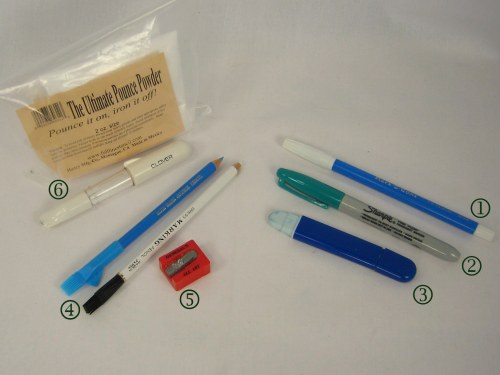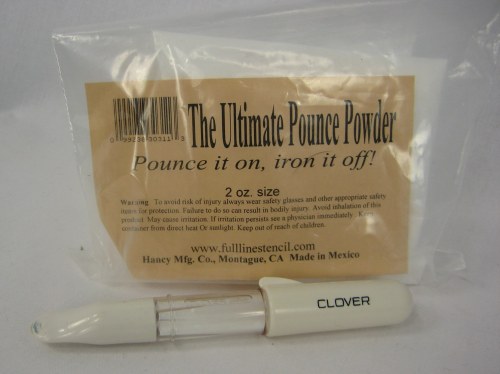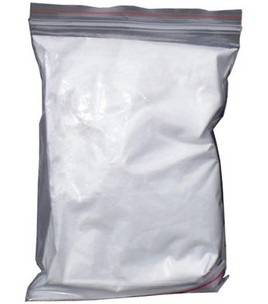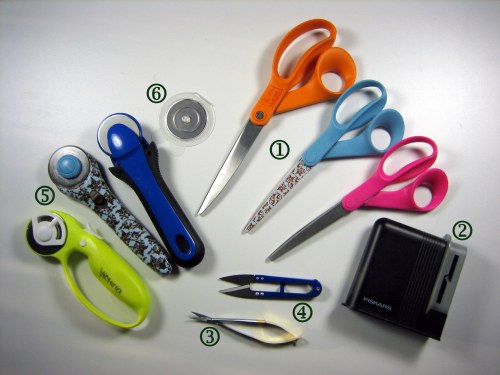 Good marking tools can help make a project much easier to complete. Here are the marking tools that I use the most often:
Good marking tools can help make a project much easier to complete. Here are the marking tools that I use the most often:
1. Water Soluble Pen: The ink of this marker disappears in cool water, so it’s great for cottons and other washable fabrics. The ink usually will soak through layers of fabric, which can be good if you’re marking darts, and not so good…well, if you don’t want your marks to show through. To remove marks, I spritz with a spray bottle or run under the faucet. Make sure you let the fabric air dry completely before ironing, or the heat might set the marks. Another tip: if the pen begins to dry out, open up the end, and drop some water into the barrel; soak the tip in water as well . Usually, this will bring the pen back to life, at least long enough until the next time you can get to the craft store!
2. Permanent Marker: This might seem like the opposite of any marking tool you would want in your sewing room, but if you’re marking someplace that will be completely hidden (like cutting lines), a permanent marker is good because the ink won’t run or stain the rest of your project after washing and using. Just be careful that you really put the marks where you mean to and that the ink doesn’t soak onto anything you don’t want it to! (I also like to mark all my sewing tools with my name or initials so that when sewing with friends, we never mix up our notions!)
3. Slim Chaco-Liner: This particular product is made by Clover, though there are probably other brands. This nifty tool has a wheel that dispenses powder chalk onto your project. It’s nice for creating thin lines that are usually easy to brush off, and often they will get your chalk onto hard to mark fabric like fleece. They come in white, blue, yellow, and red (and maybe even more!)
4. Dressmaker’s Pencil: These dressmaker’s pencils are often chalk and usually water soluble. I usually only use them on marks that won’t be seen, but because they are chalk, if you mark on the wrong side of the fabric, the marks usually won’t show through to the front side of your project. When you sharpen the tips to a point, you can make very precise marks.
5. General’s All Art Sharpener: This is my favorite sharpener because it creates perfect points like when your pencils were new! I find them in the fine arts department of my local craft store.
6. Pen-Style Clover Chaco-Liner and Ultimate Pounce Powder: This combination of marking tools is hands down my favorite and most used marking tool. I bought a Clover Pen-Style Chaco-Liner (because it’s a different shape than all my Slim Chaco-Liners and therefore easy to distinguish; also it has a clear barrel so I can see when it needs to be refilled) and dumped the chalk the came with it. Then I filled the barrel with the Ulitmate Pounce Powder: a white, iron-off powder! This is a great system because the Chaco-Liner can draw nice lines on almost any fabric, but the Pounce Powder irons off, so there’s no need to get your fabric wet! Of course, I would always test before using it all over a project, but I’ve used this system on everything from satin and chiffon to fleece and canvas. Unfortunately, it only comes in white, but usually that’s okay (and I have used it on white fabric before…it was hard to see, but I did it!)
 (This is a picture of The Ultimate Pounce Powder refill and the Pen Style Chaco-Liner. The Pounce Powder is a quilting tool that comes with an actual pouncer, but I can’t currently find mine! I will post a picture as soon as I do.) 🙂
(This is a picture of The Ultimate Pounce Powder refill and the Pen Style Chaco-Liner. The Pounce Powder is a quilting tool that comes with an actual pouncer, but I can’t currently find mine! I will post a picture as soon as I do.) 🙂
















You must be logged in to post a comment.